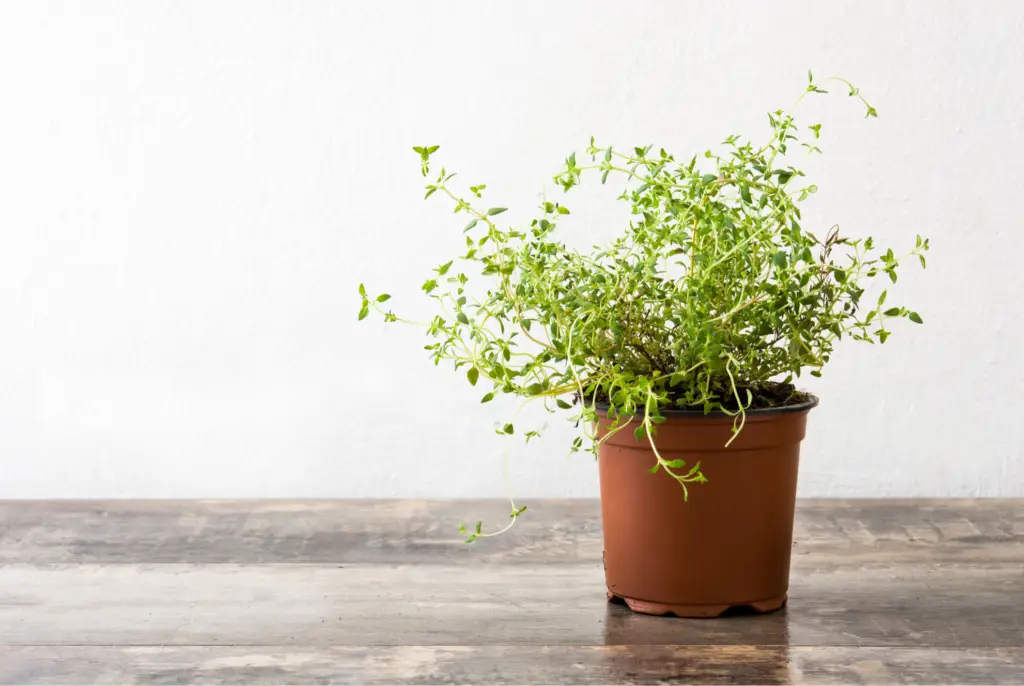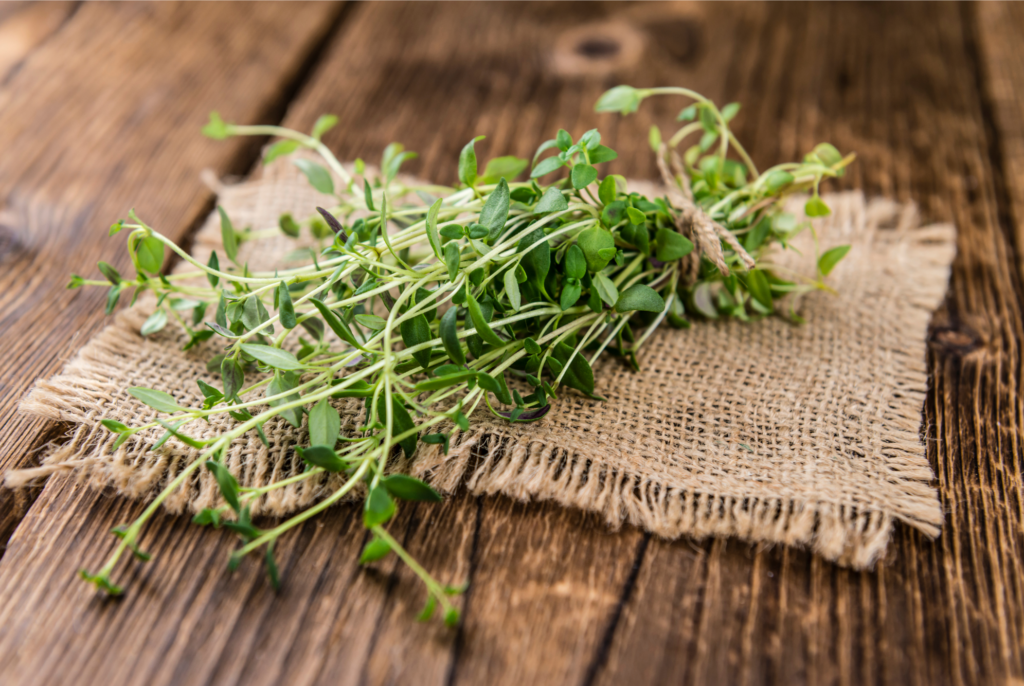Growing herbs indoors is becoming increasingly popular as more and more people are recognising the benefits of having fresh herbs at their fingertips year-round. Thyme, with its small leaves and fragrant aroma, is a great herb to grow indoors. It is relatively easy to care for and can add both flavour and beauty to your indoor space. In this article, we will discuss the steps you need to take to grow thyme as an indoor plant.
Table of Contents
Choose the right variety of thyme
There are many varieties of thyme available, but not all of them are suitable for growing indoors. Some of the most popular thyme varieties for indoor growing include:
- Lemon thyme: This variety of thyme has a lemony scent and is perfect for use in cooking, particularly with fish and poultry.
- English thyme: English thyme is a common variety of thyme that is often used in cooking. It has a strong, earthy flavour and is perfect for use in soups and stews.
- Creeping thyme: Creeping thyme is a low-growing variety of thyme that is perfect for use as a ground cover or in hanging baskets.
Choose the variety of thyme that best suits your needs and the growing conditions in your indoor space.
Provide the right growing conditions
Thyme is a hardy herb that can thrive in a variety of growing conditions. However, to ensure that your thyme plant grows and thrives indoors, you will need to provide it with the right growing conditions. Here are some tips for providing the right growing conditions for your thyme plant:
- Light: Thyme plants require at least 6 hours of direct sunlight each day. If you do not have access to natural sunlight, you can use artificial grow lights to provide your thyme plant with the light it needs.
- Temperature: Thyme plants prefer a temperature range between 60°F and 80°F (15°C and 26°C). Avoid placing your thyme plant in a drafty area or near a heat source, such as a radiator or vent.
- Humidity: Thyme plants do not require high humidity levels, but they do need some moisture in the air. You can increase humidity levels by placing a tray of water near your thyme plant or by using a humidifier.
- Soil: Thyme plants prefer well-draining soil that is rich in nutrients. You can use a potting mix that is specifically designed for herbs or create your own by mixing equal parts of peat moss, perlite, and vermiculite.
Choose the right container
When growing thyme indoors, it is important to choose the right container. Thyme plants prefer containers that are wide and shallow rather than tall and narrow. This is because thyme plants have shallow root systems and require plenty of room to spread out. Here are some tips for choosing the right container for your thyme plant:
- Size: Choose a container that is at least 6 inches (15 centimeters) in diameter to give your thyme plant plenty of room to grow.
- Material: Thyme plants do well in containers made of terra cotta or other porous materials. These materials allow for good drainage and air circulation.
- Drainage: Make sure that your container has drainage holes to allow excess water to escape. This will prevent the soil from becoming waterlogged, which can lead to root rot.
- Water your thyme plant properly
Proper watering is key to ensuring that your thyme plant grows and thrives indoors. Thyme plants prefer soil that is moist but not waterlogged. Here are some tips for watering your thyme plant: - Frequency: Water your thyme plant when the top inch of soil feels dry to the touch. This will vary depending on the humidity levels in your indoor space.
Watering requirements
Proper watering is key to ensuring that your thyme plant grows and thrives indoors. Thyme plants prefer soil that is moist but not waterlogged. Here are some tips for watering your thyme plant:
- Frequency: Water your thyme plant when the soil feels dry to the touch. This will vary depending on the humidity levels in your indoor space.
- Amount: Water your thyme plant until water drains out of the bottom of the container. Discard any excess water that collects in the saucer or tray under the container.
- Water quality: Use room temperature tap water or rainwater to water your thyme plant. Avoid using hard water, which can leave mineral deposits on the soil and leaves.
- Watering tools: Use a watering can or spray bottle to water your thyme plant. Avoid getting water on the leaves, as this can lead to fungal diseases.
Fertilise your thyme plant
Thyme plants require regular fertilisation to maintain their growth and health. Use a balanced fertiliser that is specifically designed for herbs, and follow the instructions on the label for application rates. Here are some tips for fertilising your thyme plant:
- Frequency: Fertilise your thyme plant once a month during the growing season (spring and summer). Do not fertilise during the winter, when the plant is dormant.
- Application: Apply the fertiliser to the soil around the base of the plant. Do not get fertiliser on the leaves or stems, as this can burn the plant.
- Organic fertilisers: If you prefer to use organic fertilisers, you can use compost tea or a fish emulsion fertiliser.


Prune your thyme plant
Regular pruning is important for maintaining the shape and health of your thyme plant. Pruning also encourages the plant to produce new growth, which can lead to a fuller, more robust plant. Here are some tips for pruning your thyme plant:
- Timing: Prune your thyme plant in the spring, just as new growth begins to appear.
- Technique: Use clean, sharp scissors or pruning shears to snip off the tips of the stems. This will encourage branching and new growth.
- Harvesting: When you harvest thyme leaves for culinary use, be sure to only remove a few leaves from each stem. This will allow the plant to continue to produce new growth.
Troubleshooting
Even with proper care, thyme plants can sometimes develop problems. Here are some common issues and how to address them:
- Overwatering: If the leaves of your thyme plant turn yellow and drop off, it may be a sign of overwatering. Reduce watering and make sure the container has adequate drainage.
- Underwatering: If the leaves of your thyme plant become dry and brittle, it may be a sign of underwatering. Increase watering and make sure the soil is moist but not waterlogged.
- Pests: Thyme plants are relatively pest-resistant, but they can sometimes attract spider mites or aphids. Use an insecticidal soap to treat infestations.
- Disease: Thyme plants can sometimes develop fungal diseases, such as powdery mildew or root rot. Remove any affected leaves or stems and improve air circulation around the plant.
Conclusion
Growing thyme as an indoor plant can be a rewarding experience for both novice and experienced gardeners. By following these simple steps, you can grow a healthy and productive thyme plant in your indoor space. With proper care and attention, your thyme plant will provide you with fresh herbs for cooking and a beautiful addition to your indoor decor.

